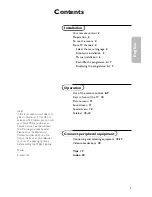
Circuit Descriptions, Abbreviation List, and IC Data Sheets
EN 111
EJ2.0U LA
9.
9.4
Abbreviation List
0/6/12
SCART switch control signal on A/V
board. 0 = loop through (AUX to TV), 6
= play 16:9 format, 12 = play 4:3
format
2DNR
Spatial (2D) Noise Reduction
3DNR
Temporal (3D) Noise Reduction
AARA
Automatic Aspect Ratio Adaptation:
algorithm that adapts aspect ratio to
remove horizontal black bars; keeps
the original aspect ratio
ACI
Automatic Channel Installation:
algorithm that installs TV channels
directly from a cable network by
means of a predefined TXT page
ADC
Analogue to Digital Converter
AFC
Automatic Frequency Control: control
signal used to tune to the correct
frequency
AGC
Automatic Gain Control: algorithm that
controls the video input of the feature
box
AM
Amplitude Modulation
ANR
Automatic Noise Reduction: one of the
algorithms of Auto TV
AP
Asia Pacific
AR
Aspect Ratio: 4 by 3 or 16 by 9
ASF
Auto Screen Fit: algorithm that adapts
aspect ratio to remove horizontal black
bars without discarding video
information
ATSC
Advanced Television Systems
Committee, the digital TV standard in
the USA
ATV
See Auto TV
Auto TV
A hardware and software control
system that measures picture content,
and adapts image parameters in a
dynamic way
AV
External Audio Video
AVIP
Audio Video Input Processor
B/G
Monochrome TV system. Sound
carrier distance is 5.5 MHz
BTSC
Broadcast Television Standard
Committee. Multiplex FM stereo sound
system, originating from the USA and
used e.g. in LATAM and AP-NTSC
countries
B-TXT
Blue TeleteXT
C
Centre channel (audio)
CA(M)
Conditional Access (Module)
CEC
Consumer Electronics Control bus:
remote control bus on HDMI
connections
CIS
Card Information Structure: Protocol
which identifies the card in a POD
module
CL
Constant Level: audio output to
connect with an external amplifier
COLUMBUS
COlor LUMinance Baseband
Universal Sub-system
ComPair
Computer aided rePair
CP
Connected Planet / Copy Protection
CSM
Customer Service Mode
CSS
Content Scrambling System; An
encryption method for MPEG-2 video
on DVDs. The algorithm and keys
required to decode the disc are stored
on the DVD-player
CTI
Color Transient Improvement:
manipulates steepness of chroma
transients
CVBS
Composite Video Blanking and
Synchronization
DAC
Digital to Analogue Converter
DBE
Dynamic Bass Enhancement: extra
low frequency amplification
DDC
See "E-DDC"
D/K
Monochrome TV system. Sound
carrier distance is 6.5 MHz
DFU
Directions For Use: owner's manual
DMR
Digital Media Reader: card reader
DNR
Digital Noise Reduction: noise
reduction feature of the set
DRAM
Dynamic RAM
DRM
Digital Rights Management
DSP
Digital Signal Processing
DST
Dealer Service Tool: special remote
control designed for service
technicians
DTCP
Digital Transmission Content
Protection; A protocol for protecting
digital audio/video content that is
traversing a high speed serial bus,
such as IEEE-1394
DVD
Digital Versatile Disc
DVI(-d)
Digital Visual Interface (d= digital only)
EAS
Emergency Alert Signalling; A cable
TV standard (SCTE18) to signal
emergency information to digital
terminal devices
ECM
Entitlement Control Message
E-DDC
Enhanced Display Data Channel
(VESA standard for communication
channel and display). Using E-DDC,
the video source can read the EDID
information form the display.
EDID
Extended Display Identification Data
(VESA standard)
EEPROM
Electrically Erasable and
Programmable Read Only Memory
EMI
Electro Magnetic Interference
EMM
Entitlement Management Message
EPLD
Erasable Programmable Logic Device
EU
Europe
EXT
EXTernal (source), entering the set by
SCART or by cinches (jacks)
FAT
Forward Application Transport
channel
FBL
Fast BLanking: DC signal
accompanying RGB signals
FDC
FDS
Full Dual Screen (same as FDW)
FDW
Full Dual Window (same as FDS)
FLASH
FLASH memory
FM
Field Memory or Frequency
Modulation
FPGA
Field-Programmable Gate Array
FTV
Flat TeleVision
Gb/s
Giga bits per second
G-TXT
Green TeleteXT
H
H_sync to the module
HD
High Definition
HDD
Hard Disk Drive
HDCP
High-bandwidth Digital Content
Protection: A "key" encoded into the
HDMI/DVI signal that prevents video
data piracy. If a source is HDCP coded
and connected via HDMI/DVI without
the proper HDCP decoding, the
picture is put into a "snow vision"
mode or changed to a low resolution.
For normal content distribution the
source and the display device must be
enabled for HDCP "software key"
decoding.
HDMI
High Definition Multimedia Interface
















































